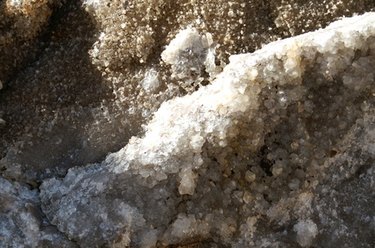
Gypsum forms as mineral deposits when sea water evaporates. These deposits are composed of calcium sulphate and water. Layers of gypsum deposits are excavated, then fed into a crusher then grind the crushed rock into a fine powder. The material is then heated to evaporate some of its inherent water molecules. This process forms the basis of gypsum plaster. Several gypsum plaster types exist, but most contain this hemi-hydrate form of gypsum powder. Other plasters contain fully dehydrated gypsum, but must also contain accelerators to force the gypsum to recombine with water prior to usage.
Malleability
Video of the Day
When gypsum plaster combines with water, the plaster becomes malleable and easy to shape. Builders and artists favor this malleable property of gypsum plaster for use in molding of interior design elements and sculptural forms.
Video of the Day
Quick Setting
Gypsum plaster sets, or dries, quickly. Some gypsum plasters contain retarders to slow drying time. Lime is slow to set so a combination of lime and gypsum plasters sets at a medium speed. While setting, gypsum plaster expands slightly and lime contracts slightly. Using a plaster with lime and gypsum holds an advantage for those using plaster for detailed work; the plaster does not crack from the contraction of lime, nor does it overly enlarge from the expansion of gypsum. Gypsum plaster's shape remains intact after setting except under pressure from carving or striking or the application of additional plaster.
Fire Resistance
Gypsum contains nearly 50 percent water, which accounts for gypsum plaster's fire resistance. In gypsum molecules, water forms crystals that do not melt like ice, but only escape at high temperatures. It is this high concentration of water in gypsum that accounts for its fire resistance. At high temperatures, gypsum does not readily burn because it first releases its water molecules. This quality of fire resistance contributes to gypsum's desirability in building and construction.